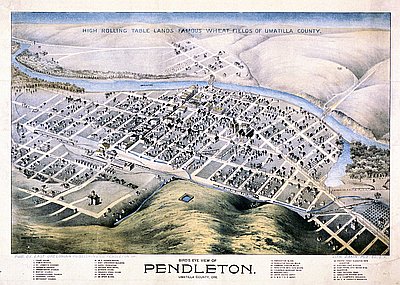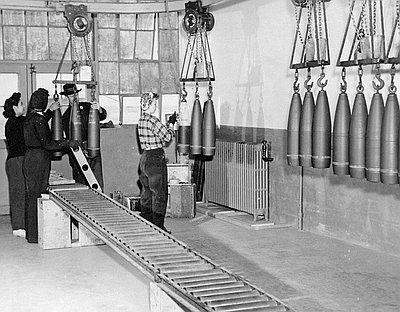- Catalog No. —
- OrHi 71475
- Date —
- August 1941
- Era —
- 1921-1949 (Great Depression and World War II)
- Themes —
- Transportation and Communication
- Credits —
- Oregon Historical Society
- Regions —
- Northeast
- Author —
- Bus Howdyshell
Pendleton Field
This aerial photograph shows Pendleton Field, also known as Pendleton Army Air Base, in August 1941. It was taken by Pendleton photographer Bus Howdyshell. The attached caption notes that the large building under construction is an aircraft hanger, while the group of buildings in the left center area is the hospital unit.
In 1941, the U.S. Army Corps of Engineers constructed Pendleton Field and several other military bases in the Pacific Northwest in response to the growing possibility of American involvement in the war in Europe and East Asia. It took the Corps of Engineers six months to expand Pendleton’s municipal airport and to construct new runways, hangars, and other buildings to serve the 2,500 personnel that would be stationed at the base.
In June 1941, the U.S. Army Air Forces’ 17th Bombardment Group was transferred to Pendleton. After the attack on Pearl Harbor on December 7, 1941, the unit flew anti-submarine patrols to protect shipping lanes along the coasts of Oregon and Washington. Nine Japanese submarines operated off the West Coast in late 1941 and 1942. They attacked numerous ships during this period, sinking several of them, including the Connecticut, a freighter sunk off the coast of Washington in June 1942, and the Camden, a tanker sunk off the coast of Oregon in October 1942. Japanese subs also shelled Fort Stevens near Astoria in June 1942, the first foreign attack on the continental United States since the War of 1812, and launched an incendiary attack near Bandon in September 1942.
Members of Pendleton’s 17th Bombardment Group participated in one of the most famous missions of World War II, the Doolittle raid on Tokyo. Conducted in April 1942 in response to the attack on Pearl Harbor, the Doolittle raid was the first bombardment of Japan by American forces. Although it did not cause extensive damage, it shook Japanese morale by proving they were vulnerable to American attacks. Lt. Col. James Doolittle earned the Congressional Medal of Honor for leading the attack, and the crewmen, five of whom were Oregonians, received the Distinguished Flying Cross.
After the 17th Bombardment Group was transferred to South Carolina in February 1942, Pendleton Field served primarily as a training post for fighter pilots. When the war ended in August 1945 the field was converted back into a civilian airport, today known as the Eastern Oregon Regional at Pendleton.
Written by Cain Allen, © Oregon Historical Society, 2005.
Related Historical Records
-
Bird's-Eye View of Pendleton
This bird’s-eye view, published by the East Oregonian Publishing Company, shows the town of Pendleton around 1890. Bird’s eye views, also known as panoramic maps, were popular ways …

-
Workers at the Umatilla Ordnance Depot, 1943
This photograph shows workers at the U.S. Army’s Umatilla Ordnance Depot stenciling and inspecting 155-millimeter artillery shells. It was taken by an Oregon Journal photographer in April 1943. …

